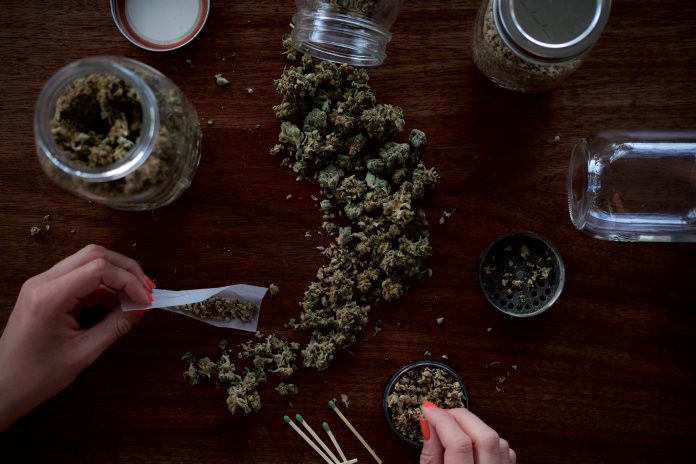Harvest is the most awaited time for many marijuana growers!
After weeks, months of tending your plants, ensuring that they have proper lighting, temperature, and nutrients, you eventually get to reap the reward. As you trim the leaves off of your big, juicy buds, you finally begin to take stock of how you’ll harvest a crop of frosty, fragrant cannabis flowers that you can’t wait to enjoy.
However, cannabis buds should be dried first. While you may be tempted to dry your harvested cannabis quickly, taking enough time to cure your cannabis correctly will provide a better final product.
What is Curing Cannabis?
Curing cannabis is the final step in growing and harvesting your dried cannabis flowers ready for consumption. It is the process of getting rid of the moisture trapped deep within the cannabis buds under regulated environmental conditions. Those juicy buds are dribbling with resin, and if dried too quickly, it can result in exceedingly dry buds that cause throat burning sensation when smoked or even flowers with moisture trapped deep inside, resulting in mold.
Importance of Curing Cannabis
Curing is vital; however, an overlooked aspect of cannabis cultivation, it has a significant effect on the final quality of cannabis flower. Here are the top reasons why you should cure your cannabis:
Curing affects the quality of smoke and taste
A slow curing process maintains terpenes, the fragrant compounds that give flowers a unique flavor and smell. Curing cannabis buds at low temperatures help keep these terpenes, unlike high temperatures that degrade the sweet aroma.
During the drying process, temperatures as low as 70 degrees Fahrenheit create the most favorable environment for aerobic bacteria and enzymes that help in breaking down unpleasant sugars and excess minerals produced during chlorophyll decomposition. The presence of excess minerals and sugars leads to harsh, scorching throat you get from smoking cannabis flowers that have been cured improperly.
Curing cannabis increases potency
Adequately cured buds are not only flavorsome to smoke but also have a subtler blend of cannabinoids. Growing conditions and strains aren’t the only determining factors whether your weed becomes a top shelf or not. As cannabis plants burgeon and fully-fledge, they go through a process known as biosynthesis, where chemical compounds get transformed into new ones. For instance, THCA becomes THC, the primary psychoactive compound in cannabis.
The process doesn’t stop when you harvest your cannabis. Keeping fresh cannabis under favorable temperatures and humidity levels will continue the conversion of non-psychoactive compounds to THC. In the long run, you’ll end up with more potent buds.
Curing prolongs the shelf life of cannabis
Thoroughly cured flowers preserve cannabis for a long time without fretting about molds or losing any of the cannabinoid content. It can be disheartening to go through the whole process of growing and drying cannabis, only to be ravaged by mold while in storage. If you’re looking to store your cannabis for future use, it’s crucial to properly cure your flowers to avoid disappointments. Well-cured cannabis flowers can last for more than two years when stored in a dark, cool, and dry place in an airtight container, without any considerable degradation of potency.
Step-by-step Guide on Curing Cannabis
Perhaps, you’re asking yourself how long it will take to cure weed; even though it’s a prolonged process, it is worth the wait. While there are several methods to cure cannabis flowers, the majority of the people use one standard way that has shown super results in producing high-quality buds suitable for consumption.
Step #1: Initial Cannabis Drying
Before you begin the drying and curing process, ensure that you have all you need, including wide-mouthed mason jars, hygrometer, drying rack, and humidipacks. While hygrometer and humidipacks are optional, they make things easier by measuring the humidity and ensuring that your cannabis doesn’t get overly dry.
The drying process starts as soon as you harvest your cannabis. When you cut down the plant, you’ll immediately notice how wet and sticky buds are. This is a perfect sign of your plant’s resin levels. Let’s go through the cannabis drying steps.
Cut down the plant
How you finalize this step depends on how you harvest your plant. However, the most common method is cutting the branches 12-16” from the plant, removing undesirable leaves, and hanging the branches on a drying rack or a string.
To harvest your cannabis plant, cut the branches at the base of the stem. For extra-large branches, you can cut them into different sections. The size of your cuttings relies on your drying method. Some marijuana growers cut the whole plant and hang upside down to dry, while others snip the branches or individual buds and placing them on drying racks.
Trimming
Trimming is the second step of cannabis drying. You can trim your plants when wet or wait until they dry. Top-shelf cannabis is trimmed when wet, either using bud trimming machine or by hand using heavy-duty scissors. Trimming is pretty simple. While it is an overwhelming task, bud trimming machines can make the job quite easier.
Drying
Once you’ve harvested your cannabis, you can dry your weed by placing them in a dark room keeping temperatures between 60-70 degrees Fahrenheit and a humidity level between 45-50%. Ventilation is crucial, so having a fan will help preserve the aroma and the taste of your flowers. Also, having a dehumidifier is essential to ensure that the conditions are kept in the required range.
When the smallest branches snap when you bend them, or the buds feel crunchy on the outside, this is a perfect indication that you’re all set for the curing process. Depending on the environmental conditions and the bulkiness of the buds, it can take anywhere between 5-15 days to finalize the drying process.
Step #2 Cannabis Cure
Once your cannabis flowers are perfectly dry, it’s time to move to the final curing process. While these can take weeks, and a little patience, proper cannabis curing is vital for optimal flavor and potency.
- First of all, you’ll want to separate your buds from the branches if you haven’t done so. Use gloves to keep resin off your skin and for health purposes.
- With your airtight containers ready, place your trimmed cannabis buds inside. The most commonly used containers are wide mouth quartz-size mason jars because it allows for maximum moisture exchange. However, plastic, metal, ceramic, or wood vessels can work perfectly as well.
Some people use oven bags that work pretty well. Plastic bags are not ideal for curing since they don’t let in oxygen and can devalue buds when they come in contact with terpenes in cannabis. Packs the buds loosely into your mason jars without overpacking them to allow free flow of air and avoid crushing them.
- Seal your containers and store them in a dark, cool place to finalize the process. While you’ll realize that the flowers are not dry and crunchy from the outside on the first day, this is due to rehydration of the moisture from inside the buds.
- Open the mason jars or containers multiple times a day during week one. This allows excess moisture to exude while replenishing oxygen. This is called “burping.” A good burp is about 5-10 minutes exposed to air. You’ll find something pretty cool after the first day or so – all of the crunchy is gone from the flowers. This is because moisture is escaping from the container. If they’re still crunchy, you overdid the drying process.
Also, if you notice an ammonia odor when opening the mason jars, it means your flowers are not dry enough, and you started this process early. This may lead to mildewed cannabis because of aerobic bacteria.
- You’ll need to open the jars after the first week for a few days and let the flowers breathe for a few minutes. After 2-3 weeks, the cannabis will be adequately cured to offer quality flavor and potency. However, 4-8 weeks curing time will upgrade the quality even more. Depending on the strain, some may take up to 6 months of curing.
Wrap Up On How to Cure Cannabis
While the curing process is the most disregarded aspect of cannabis cultivation, an activity that was overlooked when the cannabis products were not readily available. Due to the stiff competition in the cannabis industry: medical and recreational cannabis markets, growers are now paying attention to the curing process that gives a high-quality final product.
Table of Contents

















![How to Use Carbon Filters in Your Grow Room [7 Best Carbon Filters for Grow Rooms in 2021] How to Use Carbon Filters in Your Grow Room](https://420arena.com/wp-content/uploads/2020/12/How-to-Use-Carbon-Filters-in-Your-Grow-Room-218x150.jpg)







![How to Make a DIY Bubble Cloner [Complete Guide] How to Make a DIY Bubble Cloner](https://420arena.com/wp-content/uploads/2021/02/How-to-Make-a-DIY-Bubble-Cloner-218x150.jpg)





